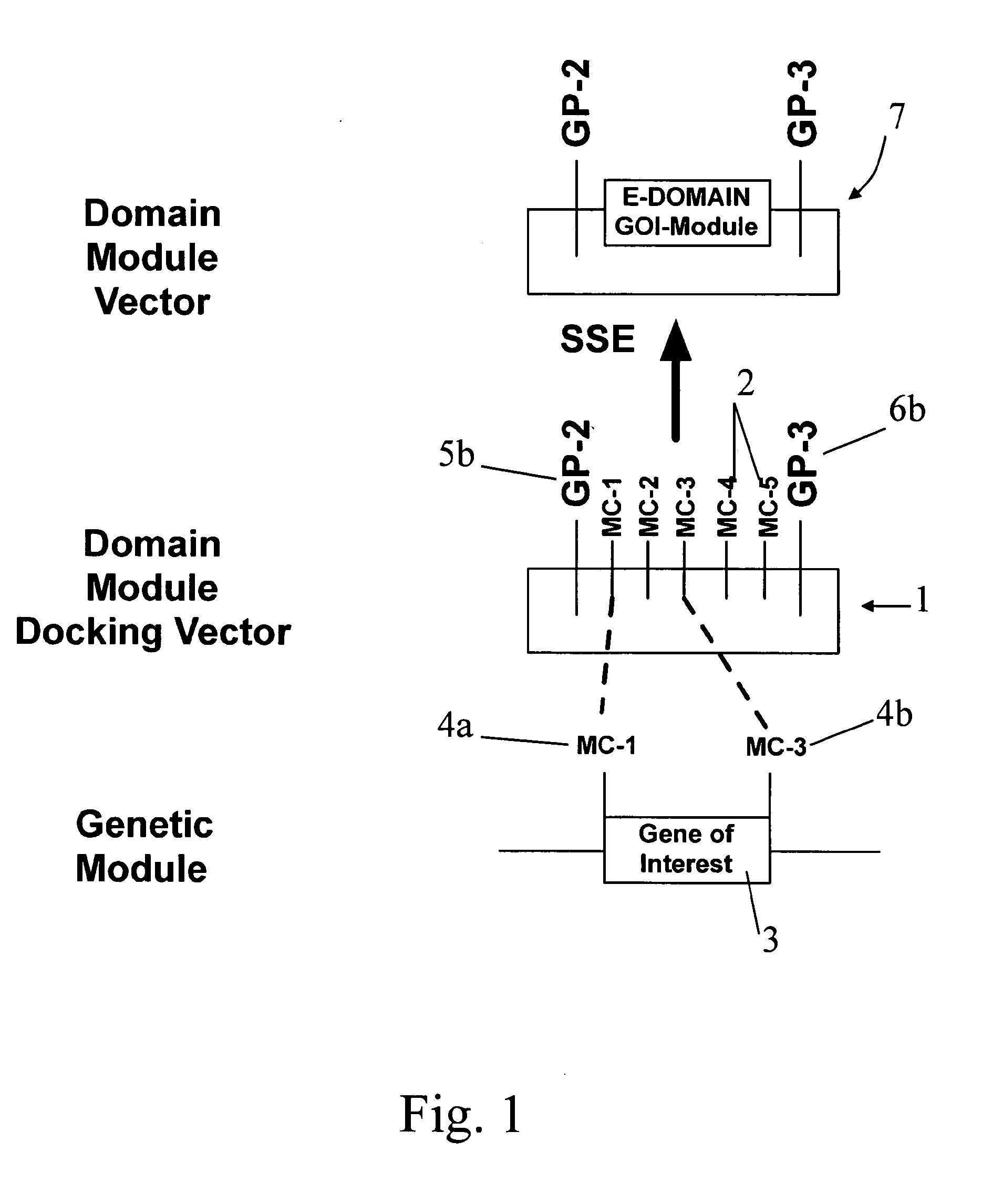DNA modular cloning vector plasmids and methods for their use
a plasmid and modular technology, applied in the field of cloning vector plasmids, can solve the problems of difficult manipulation, statistically very likely, and many sites of 6 or less nucleotides being useless,
- Summary
- Abstract
- Description
- Claims
- Application Information
AI Technical Summary
Benefits of technology
Problems solved by technology
Method used
Image
Examples
first embodiment
[0124]FIG. 1 shows a simplified representation of the present invention, of a domain module docking vector 1. The vector 1 consists of a string of DNA having multiple cloning site 2, and is typically a plasmid. The domain module docking vector comprises a multiple cloning module (MC module) consisting of five cloning sites arranged in sequence, MC-1, MC-2, MC-3, MC-4, and MC-5. The multiple cloning site comprises a plurality of restriction sites that are independently selected from common restriction sites, as described herein after. Two of the restriction sites define a docking position for the genetic material of interest, illustrated as a gene of interest 3. The MC module enables the sub-cloning of a genetic material of interest between two of the restriction sites in the multiple cloning site of the MC module. The gene of interest 3 is typically released from a gene of interest vector (not shown), and includes a pair of cloning sites 4a and 4b, shown as MC-1 and MC-3.
[0125] The ...
second embodiment
[0126] In the invention, the cognate restriction enzymes MC-1 and MC-3 (not shown) can cut the gene of interest from its vector, and open the MC module at both the MC-1 and MC-3 MC sites, thereby allowing ligation of the gene of interest into between the MC-1 and MC-3 MC sites, thereby forming a domain module vector 7. In the illustrated embodiment, the gene of interest comprises an Expression domain, so that the domain module is an Expression module and the domain module vector is more particularly an Expression module vector. The Expression module vector comprises an Expression module 8, which comprises the first and second gene pivots 5 and 6 that flank a nucleic acid sequence comprising the sub-cloned gene of interest 3 that includes the Expression domain.
[0127] In the illustrated embodiment, the gene of interest comprises an Expression domain, wherein the first gene pivot (or 5′ portion of the Expression domain) is hereinafter referred to as GP2 and the second gene pivot (or 3′...
third embodiment
[0133]FIG. 2 shows a simplified representation of the present invention, of a first PE3 docking vector 10. The PE3 docking vector 10 consists of a string of DNA having at least a first cloning module 11b, and is typically a plasmid. The at least first cloning module comprises at least a first and a second gene pivot, illustrated as GP2 and GP3, which flank a nucleic acid sequence that comprises stuffer 18b. A DNA stuffer domain is a random nucleotide sequence that does not encode for a restriction site or any other biological function resident within the PE3 docking vector. Stuffer DNA serves to increase the efficiency of restriction enzyme cutting activity by providing longer stretches of DNA to which the restriction enzyme can bind. This is important because many restriction enzymes cannot bind to and cut their cognate recognition sites if DNA lengths are limiting. The first and second gene pivots are as described herein before. The first cloning module 11b is configured for cloni...
PUM
| Property | Measurement | Unit |
|---|---|---|
| nucleic acid | aaaaa | aaaaa |
| nucleic acid sequence | aaaaa | aaaaa |
| structure | aaaaa | aaaaa |
Abstract
Description
Claims
Application Information
 Login to View More
Login to View More - R&D
- Intellectual Property
- Life Sciences
- Materials
- Tech Scout
- Unparalleled Data Quality
- Higher Quality Content
- 60% Fewer Hallucinations
Browse by: Latest US Patents, China's latest patents, Technical Efficacy Thesaurus, Application Domain, Technology Topic, Popular Technical Reports.
© 2025 PatSnap. All rights reserved.Legal|Privacy policy|Modern Slavery Act Transparency Statement|Sitemap|About US| Contact US: help@patsnap.com



